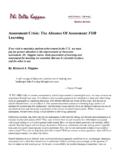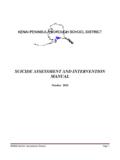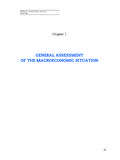Transcription of The effect of the global financial crisis on OECD ...
1 OECD Journal: Economic StudiesVolume 2014 OECD 201541 The effect of the global financial crisison OECD potential outputbyPatrice OllivaudandDavid Turner* potential output losses from the global financial crisis are estimated by comparing recentOECD published projections with a counter-factual assuming a continuation of pre-crisisproductivity trends and a trend employment rate which is sensitive to demographic the 19 OECD countries which experienced a banking crisis over the period 2007-11the median loss in potential output in 2014 is estimated to be about 5 per cent, comparedwith a loss in aggregate potential output across all OECD countries of about 3 per loss does, however, vary widely across countries, being more than 10% for severalsmaller European, mainly euro area, countries. The largest adverse effects come from lowertrend productivity, which is a combination of both lower total factor productivity and lowercapital per worker.
2 Despite large increases in structural unemployment in some countries,the contribution of lower potential employment is limited because the adverse effect onlabour force participation is generally much less than might have been expected on the basisof previous severe downturns. This may partly reflect pension reforms and a tightening upof early retirement pathways. Pre- crisis conditions relating to over-heating and financialexcesses, including high inflation, high investment, large current account deficits, high totaleconomy indebtedness and more rapid growth in capital-per-worker are all correlated withlarger post- crisis potential output losses. This suggests that underlying the potential outputlosses was a substantial misallocation of resources, especially of capital, in the pre-crisisboom period. On the other hand, more competition-friendly product market regulation isassociated with smaller losses of potential output, suggesting that it facilitates areallocation of resources across firms and sectors in the aftermath of an adverse shock andso helps to mitigate its classification: E32; : Banking crisis , financial crisis , global financial crisis , potential output.
3 * The authors are economist and Head of Division, respectively, from the OECD MacroeconomicAnalysis Division of the Economics Department previous version of this paper, based on earlier vintage of data and projections, was prepared forthe 2014 Bank of Korea International Conference Strengthening Growth potential in the Aftermathof the global financial crisis , June 2-3, 2014, Bank of Korea, Seoul, Korea. The authors thankJonathan Ostry, Enrique Alberola, Peter Hoeller, Boris Cournede, Davide Furceri, Yvan Guillemette,Christine Lewis, Phil Bagnoli and Mark Pearson for valuable comments and discussions as well asInes Gomez Palacio for help with documentation statistical data for Israel are supplied by and under the responsibility of the relevant use of such data by the OECD is without prejudice to the status of the Golan Heights,East Jerusalem and Israeli settlements in the West Bank under the terms of international effect OF THE global financial crisis ON OECD potential OUTPUTOECD JOURNAL: ECONOMIC STUDIES VOLUME 2014 OECD 2015421.
4 Introduction and summaryThe global financial crisis has been extremely costly in terms of lost output and crucial judgement for macroeconomic policy is how much of this loss will persist oncecyclical recovery is complete. Specifically, what level of loss in medium-term output willremain relative to the trajectory that might have been expected in the absence of extent of such losses is a particularly important consideration for fiscal policygiven the large increase in government deficits and debt experienced by many OECD countries; the greater the loss, the less that fiscal balances will improve with any recoveryand so the greater the need for discretionary action to correct remaining fiscal extent of the loss in capacity to produce output without generating unsustainablemacroeconomic imbalances is also relevant for monetary policy; the greater the loss, thesooner any recovery will run into capacity constraints and so the sooner the need tonormalise policy rates and end unconventional monetary easing.
5 An understanding ofwhich countries have been most severely impacted by the crisis may also cast light onwhich pre- crisis conditions and policies make economies vulnerable to such shocks and sosuggest ways of improving resilience in the the effect of the crisis on medium-term output prospects is inherentlyproblematic, given the impossibility of knowing what the counter-factual is and because ofthe difficulties of disentangling the effect of the crisis from other effects, including policychanges. Moreover, even seven years after the crisis , with many economies judged to beoperating well below capacity, any assessment can only be preliminary. The approach inthe current paper is based on OECD published estimates of potential output (OECD, 2014a),which is that estimated trend level of output which can be sustained without generatinginflationary pressures.
6 Losses related to the crisis are evaluated on a country-by-countrybasis relative to a counter-factual assuming a continuation of pre- crisis labour productivitytrends, but with alternative assumptions regarding the different components of the trendemployment rate. There is only one country (Germany) out of 19 OECD countries whichexperienced a banking crisis over the period 2007-11, which did not incur a loss in potentialoutput on this basis. Nevertheless, this approach suggests (unsurprisingly) that otherfactors, including policy changes, have had an influence on potential output, particularlywhere post- crisis developments in some components of potential output for somecountries are positive relative to the counter-factual. However, a strength of the approachis that in such cases it allows an explicit adjustment to be made when there are goodreasons to suspect other influences on potential output are main findings of the paper are as follows: Among the 19 OECD countries which experienced a banking crisis over the period2007-11, the median loss in potential output in 2014 is estimated to be about 5 per cent,which is slightly higher than OECD estimates of previous major banking crises.
7 The detail of the analysis, by country and component of potential output, confirms thatthere are important effects other than just the crisis , including policy effects, acting onTHE effect OF THE global financial crisis ON OECD potential OUTPUTOECD JOURNAL: ECONOMIC STUDIES VOLUME 2014 OECD 201543potential output. Adjusting the estimates, to exclude such effects where they seem mostobvious, suggests that the loss to aggregate OECD potential output is about 3 per centinstead of 2% when not adjusting for such effects. Although there is little effect of theseadjustments on the median estimate for countries which experienced a banking crisis ,the median loss for other OECD countries is doubled to 4%. These effects are smaller than other widely-quoted estimates in the literature relating tothe medium-term output effects of past financial crises.
8 It is argued that this is becauseother studies tend to over-estimate the pre- crisis trend growth rate as a basis for thecounter-factual against which output losses are evaluated. The estimated effects of the current crisis in this paper do, however, vary widely acrosscountries. The most severely affected are overwhelmingly smaller European, mainlyeuro area, countries; the reduction in potential output in 2014 being more than 10% forthe Czech Republic, Estonia, Greece, Hungary, Iceland, Ireland, Portugal and Slovenia. ForGermany and Japan, the crisis is not estimated to have had any adverse effect onpotential output. The largest adverse effects come from lower productivity, which is a combination of bothlower total factor productivity and lower capital per worker. The decline in capital perworker accounts for more than 3 percentage points of the decline in potential output in2014 for Estonia, Iceland, Hungary, Korea and Portugal, with these countries also beingamong those in which the pre- crisis growth of capital per worker was most rapid.
9 The contribution of lower potential employment to the loss in potential is typically muchsmaller than from productivity, although this contribution is about 5 percentage pointsor more for Iceland, Ireland, Greece, Portugal, and Spain, with most of this explained byhigher structural unemployment. Adverse effects on labour force participation aremodest and generally much less than might have been expected on the basis of previoussevere downturns, which may partly reflect pension reforms and a tightening up of earlyretirement pathways. Within Europe, changes in net migration flows can also explainmuch of the estimated effect of the crisis on movements in trend , the United States is one country where there has been a marked decline intrend participation, but this is attributed mostly to demographic effects and not theeffect of the crisis .
10 In terms of pre- crisis conditions, both higher inflation and positive output gaps (ameasure of over-heating), are correlated with subsequent potential output losses. Inaddition, pre- crisis conditions relating to financial excesses, namely high investment,larger current account deficits and high total economy indebtedness are also correlatedwith larger potential output losses. This provides support to arguments thatmacroeconomic policy should be concerned with financial developments over and abovetheir immediate implications for inflation. Additionally, faster growth in the capital-per-worker component of potential growth is correlated with post- crisis potential outputlosses. These results therefore suggest that underlying the potential output losses was asubstantial misallocation of resources, especially of capital, in the pre- crisis boomperiod, with rapid growth in capital contributing to unsustainable pre- crisis productivitygrowth.
















